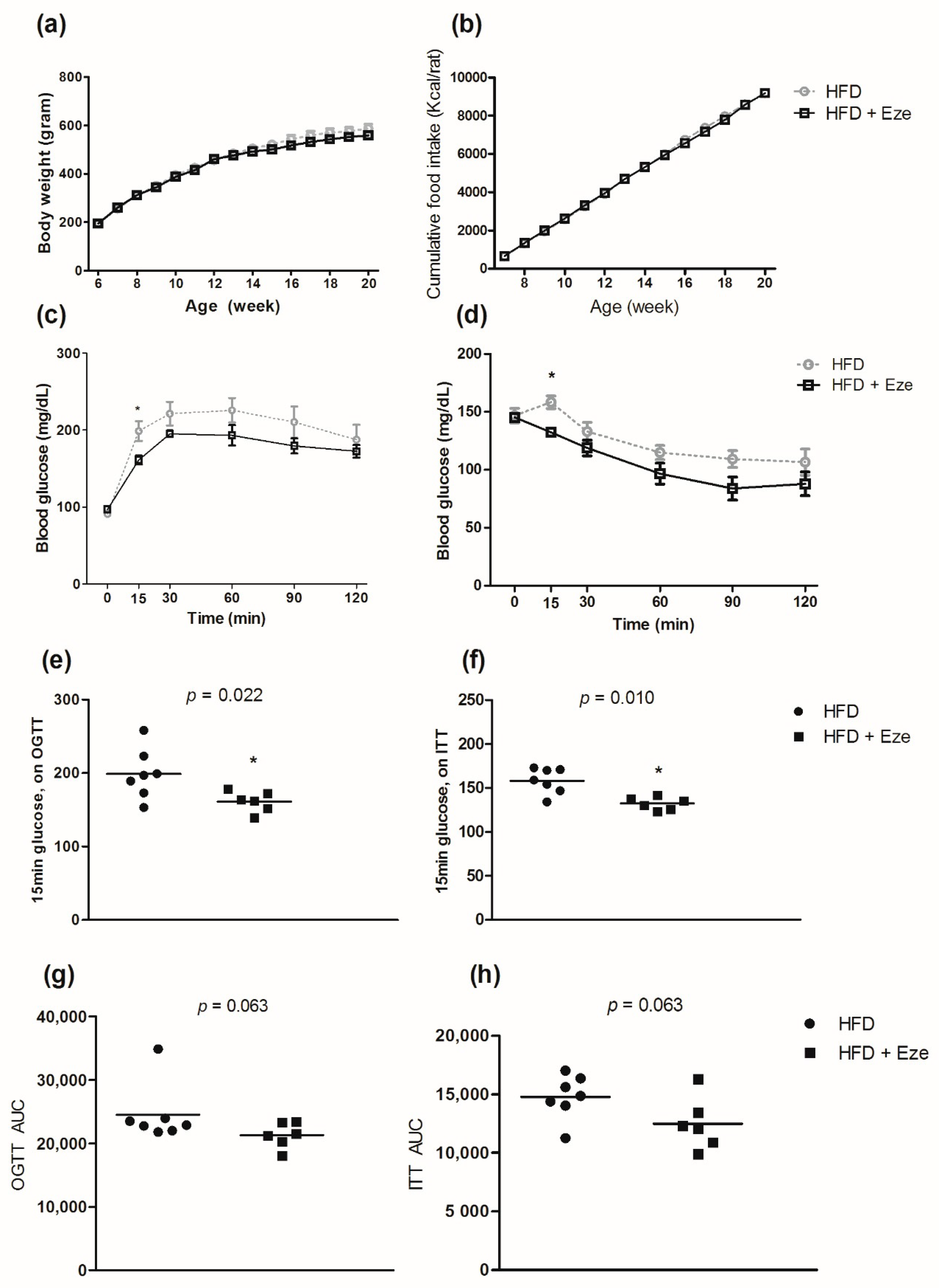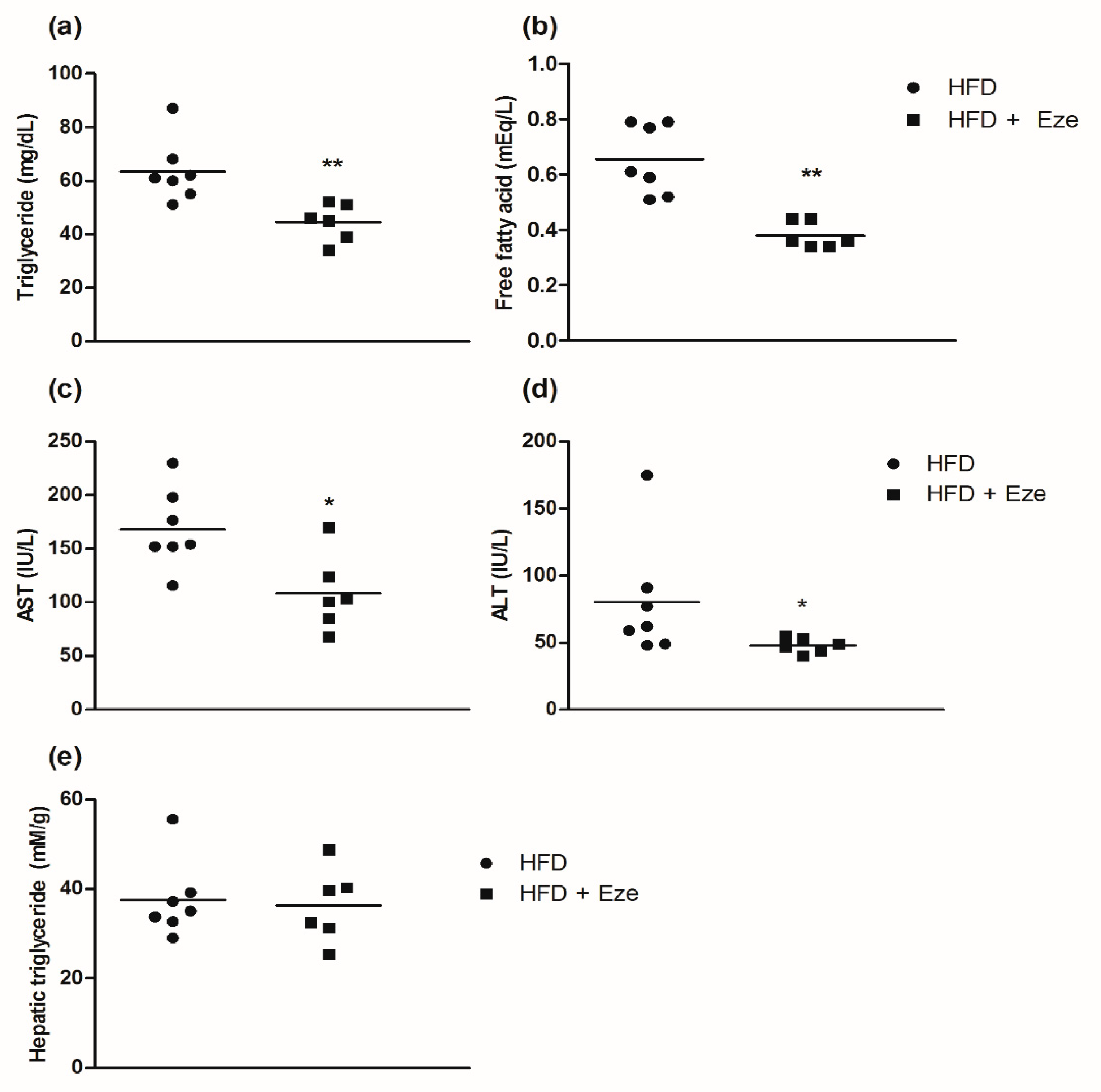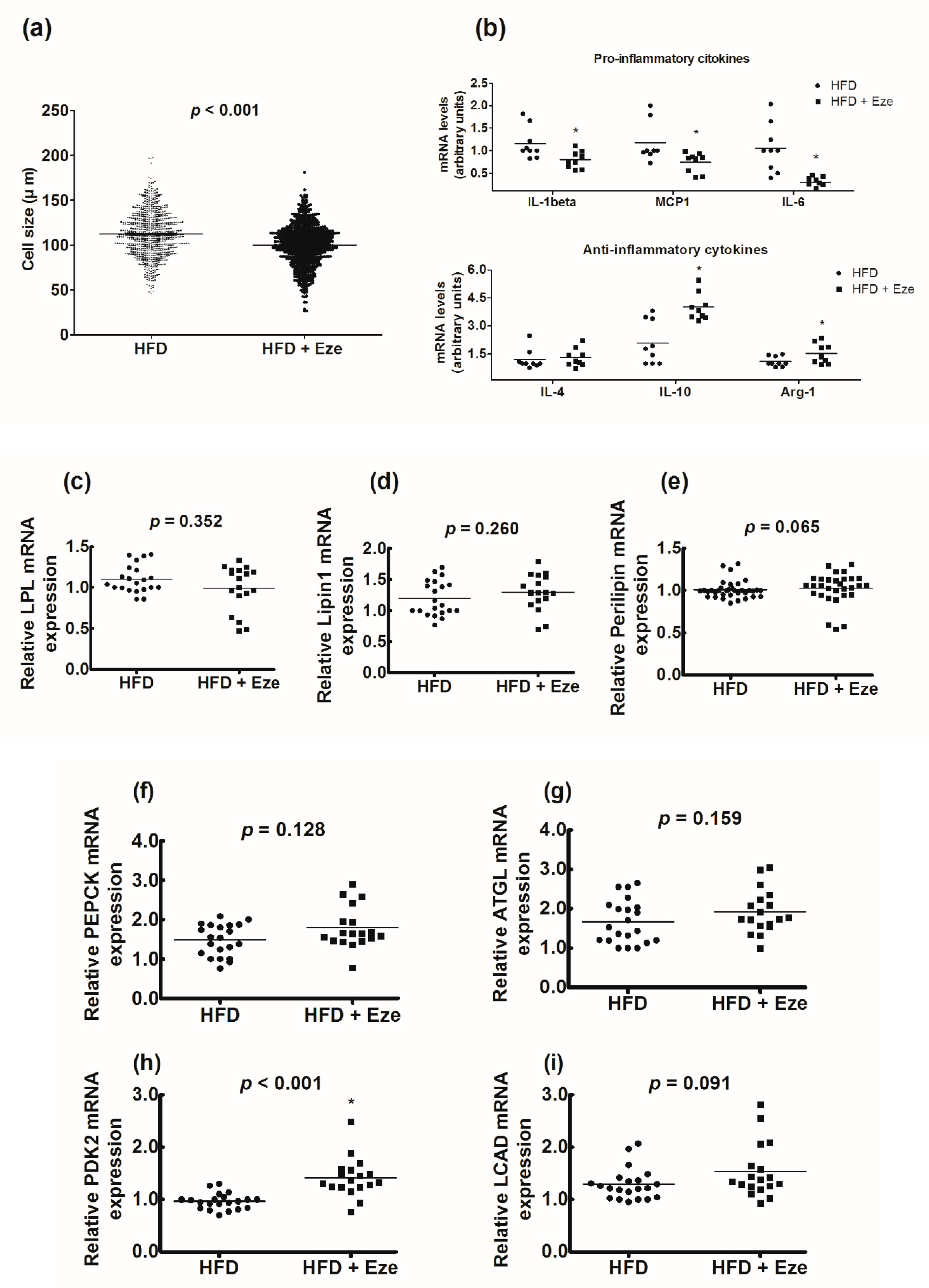Effect of Ezetimibe on Glucose Metabolism and Inflammatory Markers in Adipose Tissue
Abstract
1. Introduction
2. Experimental Section
2.1. In Vivo Study
2.2. In Vitro Study
2.3. Human Study
2.4. Statistical Analysis
3. Results and Discussion
4. Conclusions
Supplementary Materials
Author Contributions
Funding
Conflicts of Interest
Appendix A. Materials and Methods (Detailed)
Appendix A.1. In Vivo Study
Appendix A.1.1. Oral Glucose Tolerance Test (OGTT) and Insulin Tolerance Test (ITT)
Appendix A.1.2. Blood and Tissue Sampling
Appendix A.1.3. Measurement of Metabolic Parameters and Inflammation Markers (Blood)
Appendix A.1.4. Hematoxylin and Eosin (H&E) Staining
Appendix A.2. In Vitro Study
Western Blot
Appendix A.3. Quantitative Real-Time Polymerase Chain Reaction
References
- Cannon, C.P.; Blazing, M.A.; Giugliano, R.P.; McCagg, A.; White, J.A.; Theroux, P.; Darius, H.; Lewis, B.S.; Ophuis, T.O.; Jukema, J.W. Ezetimibe added to statin therapy after acute coronary syndromes. N. Engl. J. Med. 2015, 372, 2387–2397. [Google Scholar] [CrossRef]
- Preiss, D.; Seshasai, S.R.K.; Welsh, P.; Murphy, S.A.; Ho, J.E.; Waters, D.D.; DeMicco, D.A.; Barter, P.; Cannon, C.P.; Sabatine, M.S. Risk of incident diabetes with intensive-dose compared with moderate-dose statin therapy: A meta-analysis. JAMA 2011, 305, 2556–2564. [Google Scholar] [CrossRef]
- Betteridge, D.J.; Carmena, R. The diabetogenic action of statins—Mechanisms and clinical implications. Nat. Rev. Endocrinol. 2016, 12, 99–110. [Google Scholar] [CrossRef]
- Lorza-Gil, E.; Salerno, A.G.; Wanschel, A.C.; Vettorazzi, J.F.; Ferreira, M.S.; Rentz, T.; Catharino, R.R.; Oliveira, H.C. Chronic use of pravastatin reduces insulin exocytosis and increases beta-cell death in hypercholesterolemic mice. Toxicology 2016, 344–346, 42–52. [Google Scholar] [CrossRef]
- Wang, H.J.; Park, J.Y.; Kwon, O.; Choe, E.Y.; Kim, C.H.; Hur, K.Y.; Lee, M.S.; Yun, M.; Cha, B.S.; Kim, Y.B.; et al. Chronic hmgcr/hmg-coa reductase inhibitor treatment contributes to dysglycemia by upregulating hepatic gluconeogenesis through autophagy induction. Autophagy 2015, 11, 2089–2101. [Google Scholar] [CrossRef]
- Brault, M.; Ray, J.; Gomez, Y.H.; Mantzoros, C.S.; Daskalopoulou, S.S. Statin treatment and new-onset diabetes: A review of proposed mechanisms. Metab. Clin. Exp. 2014, 63, 735–745. [Google Scholar] [CrossRef]
- Colbert, J.D.; Stone, J.A. Statin use and the risk of incident diabetes mellitus: A review of the literature. Can. J. Cardiol. 2012, 28, 581–589. [Google Scholar] [CrossRef]
- Escobar, C.; Echarri, R.; Barrios, V. Relative safety profiles of high dose statin regimens. Vasc. Health Risk Manag. 2008, 4, 525. [Google Scholar] [PubMed]
- Takase, H.; Dohi, Y.; Okado, T.; Hashimoto, T.; Goto, Y.; Kimura, G. Effects of ezetimibe on visceral fat in the metabolic syndrome: A randomised controlled study. Eur. J. Clin. Investig. 2012, 42, 1287–1294. [Google Scholar] [CrossRef] [PubMed]
- Park, H.; Shima, T.; Yamaguchi, K.; Mitsuyoshi, H.; Minami, M.; Yasui, K.; Itoh, Y.; Yoshikawa, T.; Fukui, M.; Hasegawa, G. Efficacy of long-term ezetimibe therapy in patients with nonalcoholic fatty liver disease. J. Gastroenterol. 2011, 46, 101–107. [Google Scholar] [CrossRef] [PubMed]
- Takeshita, Y.; Takamura, T.; Honda, M.; Kita, Y.; Zen, Y.; Kato, K.-I.; Misu, H.; Ota, T.; Nakamura, M.; Yamada, K. The effects of ezetimibe on non-alcoholic fatty liver disease and glucose metabolism: A randomised controlled trial. Diabetologia 2014, 57, 878–890. [Google Scholar] [CrossRef] [PubMed]
- Deushi, M.; Nomura, M.; Kawakami, A.; Haraguchi, M.; Ito, M.; Okazaki, M.; Ishii, H.; Yoshida, M. Ezetimibe improves liver steatosis and insulin resistance in obese rat model of metabolic syndrome. FEBS Lett. 2007, 581, 5664–5670. [Google Scholar] [CrossRef] [PubMed]
- Loomba, R.; Sirlin, C.B.; Ang, B.; Bettencourt, R.; Jain, R.; Salotti, J.; Soaft, L.; Hooker, J.; Kono, Y.; Bhatt, A. Ezetimibe for the treatment of nonalcoholic steatohepatitis: Assessment by novel magnetic resonance imaging and magnetic resonance elastography in a randomized trial (mozart trial). Hepatology 2015, 61, 1239–1250. [Google Scholar] [CrossRef] [PubMed]
- Altmann, S.W.; Davis, H.R.; Zhu, L.-j.; Yao, X.; Hoos, L.M.; Tetzloff, G.; Iyer, S.P.N.; Maguire, M.; Golovko, A.; Zeng, M. Niemann-pick c1 like 1 protein is critical for intestinal cholesterol absorption. Science 2004, 303, 1201–1204. [Google Scholar] [CrossRef] [PubMed]
- Huff, M. Dietary cholesterol, cholesterol absorption, postprandial lipemia and atherosclerosis. Can. J. Clin. Pharmacol. = J. Can. Pharmacol. Clin. 2003, 10, 26A–32A. [Google Scholar]
- Yang, S.J.; Choi, J.M.; Kim, L.; Kim, B.-J.; Sohn, J.H.; Kim, W.J.; Park, S.E.; Rhee, E.J.; Lee, W.Y.; Oh, K.W. Chronic administration of ezetimibe increases active glucagon-like peptide-1 and improves glycemic control and pancreatic beta cell mass in a rat model of type 2 diabetes. Biochem. Biophys. Res. Commun. 2011, 407, 153–157. [Google Scholar] [CrossRef]
- Etuk, E. Animals models for studying diabetes mellitus. Agric. Biol. J. N. Am. 2010, 1, 130–134. [Google Scholar]
- Ota, T.; Takamura, T.; Kurita, S.; Matsuzawa, N.; Kita, Y.; Uno, M.; Akahori, H.; Misu, H.; Sakurai, M.; Zen, Y. Insulin resistance accelerates a dietary rat model of nonalcoholic steatohepatitis. Gastroenterology 2007, 132, 282–293. [Google Scholar] [CrossRef]
- Matthews, D.R.; Hosker, J.P.; Rudenski, A.S.; Naylor, B.A.; Treacher, D.F.; Turner, R.C. Homeostasis model assessment: Insulin resistance and beta-cell function from fasting plasma glucose and insulin concentrations in man. Diabetologia 1985, 28, 412–419. [Google Scholar] [CrossRef]
- Temel, R.E.; Tang, W.; Ma, Y.; Rudel, L.L.; Willingham, M.C.; Ioannou, Y.A.; Davies, J.P.; Nilsson, L.-M.; Yu, L. Hepatic niemann-pick c1–like 1 regulates biliary cholesterol concentration and is a target of ezetimibe. J. Clin. Investig. 2007, 117, 1968. [Google Scholar] [CrossRef]
- Ferre, P.; Foufelle, F. Hepatic steatosis: A role for de novo lipogenesis and the transcription factor srebp-1c. Diabetes Obes. Metab. 2010, 12 (Suppl. 2), 83–92. [Google Scholar] [PubMed]
- Han, D.H.; Nam, K.T.; Park, J.S.; Kim, S.H.; Lee, M.; Kim, G.; Min, B.S.; Cha, B.-S.; Lee, Y.S.; Sung, S.H. Ezetimibe, an npc1l1 inhibitor, is a potent nrf2 activator that protects mice from diet-induced nonalcoholic steatohepatitis. Free Radic. Biol. Med. 2016, 99, 520–532. [Google Scholar]
- Guilherme, A.; Virbasius, J.V.; Puri, V.; Czech, M.P. Adipocyte dysfunctions linking obesity to insulin resistance and type 2 diabetes. Nat. Rev. Mol. Cell Biol. 2008, 9, 367–377. [Google Scholar] [PubMed]
- Chung, S.; Cuffe, H.; Marshall, S.M.; McDaniel, A.L.; Ha, J.-H.; Kavanagh, K.; Hong, C.; Tontonoz, P.; Temel, R.E.; Parks, J.S. Dietary cholesterol promotes adipocyte hypertrophy and adipose tissue inflammation in visceral, but not in subcutaneous, fat in monkeys. Arter. Thromb. Vasc. Biol. 2014, 34, 1880–1887. [Google Scholar]
- Matsuzawa, Y.; Funahashi, T.; Nakamura, T. The concept of metabolic syndrome: Contribution of visceral fat accumulation and its molecular mechanism. J. Atheroscler. Thromb. 2011, 18, 629–639. [Google Scholar]
- Ragheb, R.; Shanab, G.M.; Medhat, A.M.; Seoudi, D.M.; Adeli, K.; Fantus, I. Free fatty acid-induced muscle insulin resistance and glucose uptake dysfunction: Evidence for pkc activation and oxidative stress-activated signaling pathways. Biochem. Biophys. Res. Commun. 2009, 389, 211–216. [Google Scholar]
- Labonté, E.D.; Camarota, L.M.; Rojas, J.C.; Jandacek, R.J.; Gilham, D.E.; Davies, J.P.; Ioannou, Y.A.; Tso, P.; Hui, D.Y.; Howles, P.N. Reduced absorption of saturated fatty acids and resistance to diet-induced obesity and diabetes by ezetimibe-treated and npc1l1−/− mice. Am. J. Physiol.-Gastrointest. Liver Physiol. 2008, 295, G776–G783. [Google Scholar]
- Hardy, O.T.; Czech, M.P.; Corvera, S. What causes the insulin resistance underlying obesity? Curr. Opin. Endocrinol. Diabetes Obes. 2012, 19, 81. [Google Scholar]
- Hong, N.; Lee, Y.-H.; Tsujita, K.; Gonzalez, J.A.; Kramer, C.M.; Kovarnik, T.; Kouvelos, G.N.; Suzuki, H.; Han, K.; Lee, C.J. Comparison of the effects of ezetimibe-statin combination therapy on major adverse cardiovascular events in patients with and without diabetes: A meta-analysis. Endocrinol. Metab. 2018, 33, 219–227. [Google Scholar]
- Muraoka, T.; Aoki, K.; Iwasaki, T.; Shinoda, K.; Nakamura, A.; Aburatani, H.; Mori, S.; Tokuyama, K.; Kubota, N.; Kadowaki, T. Ezetimibe decreases srebp-1c expression in liver and reverses hepatic insulin resistance in mice fed a high-fat diet. Metabolism 2011, 60, 617–628. [Google Scholar]
- Kurano, M.; Hara, M.; Satoh, H.; Tsukamoto, K. Hepatic npc1l1 overexpression ameliorates glucose metabolism in diabetic mice via suppression of gluconeogenesis. Metabolism 2015, 64, 588–596. [Google Scholar] [CrossRef] [PubMed]
- Wu, H.; Shang, H.; Wu, J. Effect of ezetimibe on glycemic control: A systematic review and meta-analysis of randomized controlled trials. Endocrine 2018, 60, 229–239. [Google Scholar] [CrossRef] [PubMed]
- Nakamura, A.; Sato, K.; Kanazawa, M.; Kondo, M.; Endo, H.; Takahashi, T.; Nozaki, E. Impact of decreased insulin resistance by ezetimibe on postprandial lipid profiles and endothelial functions in obese, non-diabetic-metabolic syndrome patients with coronary artery disease. Heart Vessel. 2019, 34, 916–925. [Google Scholar]
- Stein, E. Results of phase i/ii clinical trials with ezetimibe, a novel selective cholesterol absorption inhibitor. Eur. Heart J. Suppl. 2001, 3, E11–E16. [Google Scholar] [CrossRef]



| Combination Therapy | Monotherapy | p Value | ||
|---|---|---|---|---|
| Ezetimibe Add on Statin (n = 13) | Ezetimibe Start with Statin (n = 30) | Statin Monotherapy (n = 90) | ||
| Age (years) | 61.0 (16.5) | 58.5 (11.8) | 58.0 (10.0) | 0.467 |
| Female (%) | 9 (69.2) | 17 (56.7) | 63 (70.0) | 0.398 |
| Diabetes (%) | 2 (15.4) | 3 (10.0) | 10 (11.1) | 0.873 |
| BMI (kg/m2) | 24.0 (6.9) | 24.7 (3.9) | 24.0 (3.7) | 0.658 |
| Glucose, fasting (mg/dL) | 109.0 (27.0) | 105.0 (15.3) | 99.0 (17.0) * | 0.008 |
| Glucose, stimulated (mg/dL) | 123.5 (79.0) | 118.0 (40.0) | 111.0 (30.0) | 0.492 |
| Insulin, fasting (uU/mL) | 7.3 (9.2) | 6.1 (3.1) | 6.2 (3.6) | 0.126 |
| HOMA-IR | 2.0 (2.5) | 1.6 (0.9) | 1.5 (0.9) | 0.060 |
| HbA1c (%) | 6.1 (1.1) | 5.8 (1.0) | 5.9 (0.4) | 0.110 |
| AST (IU/L) | 22.0 (5.5) | 19.5 (6.3) | 21.0 (8.0) | 0.401 |
| ALT (IU/L) | 18.0 (17.5) | 18.5 (7.8) | 18.0 (9.5) | 0.743 |
| Total cholesterol (mg/dL) | 184.0 (38.5) | 259.0 (40.5) * | 232.0 (47.5) *,† | <0.001 |
| Triglycerides (mg/dL) | 113.0 (73.5) | 125.0 (96.5) | 132.0 (68.0) | 0.989 |
| HDL cholesterol (mg/dL) | 50.0 (14.0) | 54.0 (13.5) | 52.0 (15.0) | 0.429 |
| LDL cholesterol (mg/dL) | 112.6 (29.6) | 169.6 (36.2) * | 150.2 (52.0) *,† | <0.001 |
| Ezetimibe Combination (n = 43) | Statin Monotherapy (n = 90) | Difference between Groups | |||||
|---|---|---|---|---|---|---|---|
| Baseline | Post-Treatment | p Value | Baseline | Post-Treatment | p Value | p Value | |
| Glucose, fasting (mg/dL) | 106.0 (18.0) | 105.0 (20.0) | 0.296 | 99.0 (17.0) | 101.0 (17.3) | 0.021 | 0.996 |
| Glucose, stimulated (mg/dL) | 118.0 (58.0) | 127.0 (52.5) | 0.946 | 111.0 (30.0) | 132.0 (54.0) | 0.016 | 0.117 |
| Insulin, fasting (uU/mL) | 7.0 (3.8) | 7.3 (4.6) | 0.828 | 6.2 (3.6) | 7.3 (4.1) | 0.003 | 0.066 |
| HOMA-IR | 1.7 (0.9) | 1.8 (1.3) | 0.923 | 1.5 (0.9) | 1.8 (1.1) | 0.002 | 0.109 |
| HbA1c (%) | 6.0 (0.9) | 5.9 (0.8) | 0.793 | 5.9 (0.4) | 5.9 (0.3) | 0.758 | 0.865 |
| AST (IU/L) | 21.0 (6.0) | 23.0 (9.0) | 0.003 | 21.0 (8.0) | 23.0 (7.0) | 0.009 | 0.825 |
| ALT (IU/L) | 18.0 (9.0) | 23.0 (21.0) | 0.012 | 18.0 (9.5) | 21.0 (13.0) | 0.003 | 0.694 |
| Total cholesterol (mg/dL) | 241.0 (61.0) | 167.0 (47.0) | <0.001 | 232.0 (47.5) | 168.5 (40.3) | <0.001 | 0.850 |
| Triglycerides (mg/dL) | 125.0 (84.0) | 116.5 (71.0) | 0.347 | 132.0 (68.0) | 110.5 (76.8) | 0.014 | 0.629 |
| HDL cholesterol (mg/dL) | 53.0 (15.0) | 51.5 (18.3) | 0.175 | 52.0 (15.0) | 52.0 (16.3) | 0.077 | 0.830 |
| LDL cholesterol (mg/dL) | 154.0 (60.4) | 82.9 (38.8) | <0.001 | 150.2 (52.0) | 90.0 (30.2) | <0.001 | 0.566 |
Publisher’s Note: MDPI stays neutral with regard to jurisdictional claims in published maps and institutional affiliations. |
© 2020 by the authors. Licensee MDPI, Basel, Switzerland. This article is an open access article distributed under the terms and conditions of the Creative Commons Attribution (CC BY) license (http://creativecommons.org/licenses/by/4.0/).
Share and Cite
Cho, Y.; Kim, R.-H.; Park, H.; Wang, H.J.; Lee, H.; Kang, E.S. Effect of Ezetimibe on Glucose Metabolism and Inflammatory Markers in Adipose Tissue. Biomedicines 2020, 8, 512. https://doi.org/10.3390/biomedicines8110512
Cho Y, Kim R-H, Park H, Wang HJ, Lee H, Kang ES. Effect of Ezetimibe on Glucose Metabolism and Inflammatory Markers in Adipose Tissue. Biomedicines. 2020; 8(11):512. https://doi.org/10.3390/biomedicines8110512
Chicago/Turabian StyleCho, Yongin, Ryeong-Hyeon Kim, Hyunki Park, Hye Jin Wang, Hyangkyu Lee, and Eun Seok Kang. 2020. "Effect of Ezetimibe on Glucose Metabolism and Inflammatory Markers in Adipose Tissue" Biomedicines 8, no. 11: 512. https://doi.org/10.3390/biomedicines8110512
APA StyleCho, Y., Kim, R.-H., Park, H., Wang, H. J., Lee, H., & Kang, E. S. (2020). Effect of Ezetimibe on Glucose Metabolism and Inflammatory Markers in Adipose Tissue. Biomedicines, 8(11), 512. https://doi.org/10.3390/biomedicines8110512





